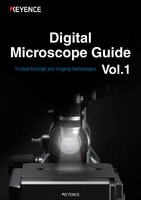Particle / Contamination Analysis
Due to increased quality requirements, prevention of contamination by foreign particles during the manufacturing processes has become progressively more important.
- Illumination Methods
- Particle / Contamination Analysis
- Quantifiable Analysis by Measuring Foreign Particles
Illumination Methods
In addition to lenses with suitable brightness and high resolution, above all it is selecting the appropriate illumination that plays a very important role. Both annular illumination and coaxial illumination can be used in order to examine the object in greater detail. When using a digital microscope to conduct a particle/contamination analysis on targets with low reflectance or which are translucent, transmitted light illumination is a good option. If the reflectance is higher and leads to gloss, diffuse illumination can help clearly distinguish the particles/contamination from the target. Changing the direction of illumination is often helpful in order to visualise foreign particles with partial illumination. Finally, polarised illumination can be of assistance if the target can only be observed through a transparent object.


- A
- Light source
- B
- Lens
- C
- Target
- D
- Half mirror


- A
- Light source
- B
- Lens
- C
- Target
- D
- Ground glass filter
The KEYENCE digital microscope has a multi-lighting function that saves all illumination data in the captured image. This allows the illumination in the image to be changed at any time, without having to capture a new image of the object.
Particle/contamination analysis can be conducted with more detail using the annular reflection minimisation of the KEYENCE digital microscope.

Particle / Contamination Analysis
Using KEYENCE's free-angle observation, users can accurately determine if the foreign particles are on or below the surface. This makes analysis easier so that potential solutions are developed quickly.

3D imaging of foreign particles is another tool for identifying solutions. During analysis, the 3D data helps determine whether the problem is a scratch or contamination by foreign particles.
Quantifiable Analysis by Measuring Foreign Particles
After the foreign particles have been observed and captured, the KEYENCE digital microscope offers a wide range of 2D and 3D measurement functions that can be carried out in real time and exported to a report using text processing or spreadsheet software.

The KEYENCE digital microscope conducts particle/contamination analysis in accordance with ISO standard 16232 and VDA 19. Measurements can be taken with a high level of accuracy due to the advanced imaging capabilities of the microscope, even measurements of 1 µm can be taken.



